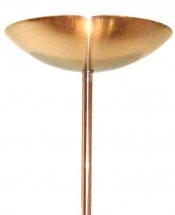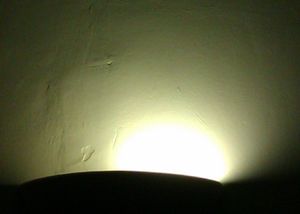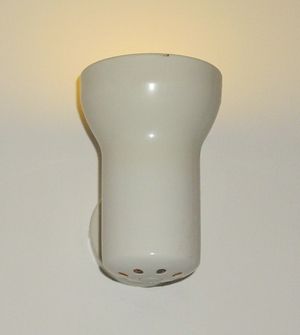Uplighters
Uplighters are light fittings that direct light output upwards. The light is bounced off a white ceiling.
Uplighters come in several flavours, each with their own strengths & weaknesses.
Pros & cons
Advantages:
- More even lighting spread than other lighting types
- Minimum shadowing
- Glare is eliminated
- Light fittings use shrouded bulbs, enabling a wide range of bulb types to be used
- Thus relatively futureproof
Disadvantages:
- Uplighting requires a white ceiling to be effective
- Ill suited ot exposed beam properties
- Not suited to very low ceiling properties (eg 6')
- There are some types of uplighter that perform poorly, though these are easily avoided
Types
Main types are:
- Halogen uplighters
- Half moon plaster uplighters
- Spotlight fittings, eg R80
- PAR38 spotlight fittings
- Trough fluorescent lighting
- Shelf fluorescent lighting
Halogen Uplighters
These are usually free standing floor lamps
- Typically 300-500w.
- High powers create excessive lighting in one area
- Thus it fails to eliminate glare and give even lighting, which are some of the main advantages of uplighting
- Power consumption is high
- Increases indoor temps on summer evenings
- Relatively expensive to run
- The lightbulbs run hot enough to ignite anything that lands on them, making them a fire risk
- Ignition temperature bulbs plus the ability to be knocked over are also not a good combination from a fire safety point of view
- Halogen bulbs run at high pressure and are known to very occasionally explode. A shower of high speed & very high temperature broken bulb pieces is probably not beneficial for health.
Half moon plaster uplighters
The bulb is positioned quite close to the wall, and this results in:
- every little blemish of the plaster is shown up, including the many slight blemishes no-one had ever noticed before.
- light intensity on the wall above the fitting is unnecessarily high
- So it fails to eliminate glare and give even lighting, which are some of the main advantages of uplighting
- Because of these shortcomings and the existence of better options, plaster half moon uplighters aren't a great choice
R80 Spotlight Fittings
- These hold the bulb in a shroud on the end of a stalk.
- Spotlight fittings that leave the bulb unshrouded produce glare
- GLS lamps (lightbulbs) are used in these fittings for uplighting rather than spotlight bulbs
- R80 fittings can also take small CFLs, but only a minority of bulbs that fit can provide as much light as a 60w filament bulb
- Bulb is positioned far enough from wall to avoid glare and excessive lighting levels just above the fitting
- Spotlight fittings are position adjustable
- Larger PAR38 fittings can take almost any CFL
- Ability to use GLS, CFL or LED makes this approach more futureproof
- R80 spotlight fittings are usually white inside the shroud. Non-white interiors require spotlight bulbs
- The fittings usually look pleasant
Open spotlights
- Extra glare compared to enclosed spotlights
- Plastic discs can crack and deteriorate
PAR38 spotlight fittings
- Shrouded fittings are large enough to take pretty much any type of bulb
- Fittings that leave the bulb unshrouded & visible are less versatile
- GLS lamps (lightbulbs) or CFLs are used in these fittings for uplighting
- Bulb is positioned far enough from wall to avoid glare and excessive lighting levels close to the fitting
- Ability to use either GLS, almost any CFL, LED, mains halogen, plus the large lamp space available makes this approach the most futureproof of all
- PAR38 spotlight fittings are much larger than R80 fittings. The appearance of the fittings is thus particularly important
- PAR38 fittings are often white inside the shroud, any fitting that isn't can only take spotlight bulbs
Trough Fluorescent Lighting
- These use linear fluorescent tubes
- Fluorescent tubes permit choice of colour temp, covering the whole range from 2700K to daylight.
- Highest efficacy and thus energy efficiency of all uplighter types
- This minimises running cost & summer heating
- Fluorescent Lighting can give very good lighting, but some precautions are needed with Fluorescent Lighting to avoid the common mistakes and achieve this.
- Fluorescent uplighters give a very wide lightspread, maximising the benefits of uplighting.
- The large size of fluorescent tubes restricts their positioning options
- Fluorescent lights can often be hidden, and their cool running temperature increases the possible positions.
Shelf Fluorescent Lighting
Similar to trough uplighting, but the fitting itself is visible
- Less visually appealing, but as simple to use as plugging a light in and putting it on a white shelf.
- Good choice for garages & workshops, where good lighting is wanted but appearance of fitting is not important.
Wood & Copper
An uncommon type of uplighter uses a varnished copper reflector to reflect coloured light upwards. These really emphasise the character and richness of timber ceilings. The energy efficiency is inevitably low, due to both reflector and timber being a non-light colour.



